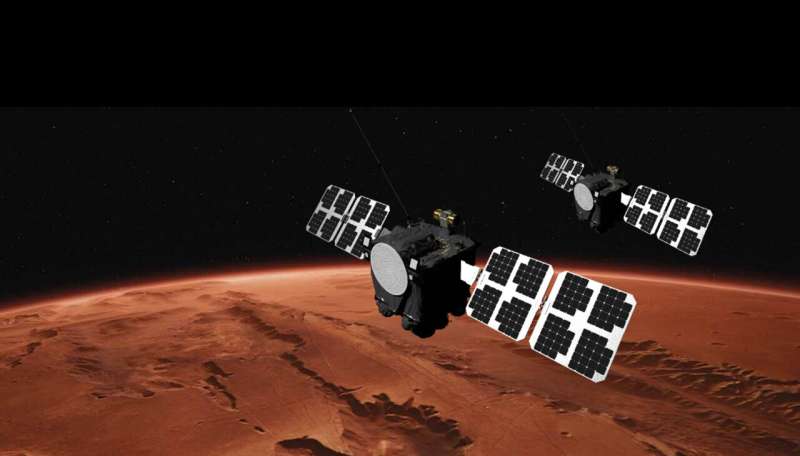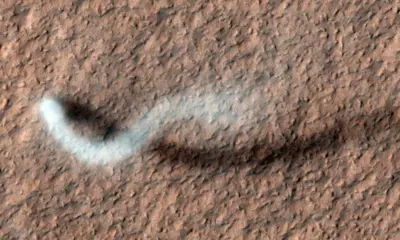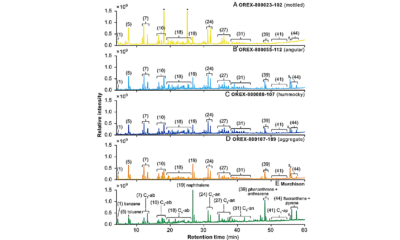Science
NASA’s ESCAPADE Mission to Mars Set for November Launch

NASA’s upcoming ESCAPADE mission, which stands for Escape and Plasma Acceleration and Dynamics Explorers, is poised to make history as the first dual-satellite mission to another planet. The two identical satellites, nicknamed Blue and Gold, are scheduled to launch no earlier than November 9, 2025, from Cape Canaveral, Florida. Managed and operated by the University of California, Berkeley, the satellites will work together to map the magnetic fields and upper atmosphere of Mars in three dimensions.
The mission aims to shed light on how Mars lost its atmosphere over time. Understanding this process is crucial for future human exploration, as it will provide insights into the Martian environment that could impact potential settlers. Principal investigator Robert Lillis of UC Berkeley’s Space Sciences Laboratory (SSL) emphasized that understanding the variability of the ionosphere is essential for correcting radio signal distortions necessary for communication on Mars.
The ESCAPADE satellites are expected to arrive at Mars in 2027. They will be controlled from SSL’s mission operations center in the hills above the Berkeley campus. The spacecraft, constructed by Rocket Lab U.S., will travel to Mars aboard a New Glenn rocket built by Blue Origin. This mission represents a significant advancement in space exploration techniques, allowing for real-time data collection that could enhance our understanding of Martian conditions.
Mapping the planet’s magnetic fields is particularly important because Mars lacks a global magnetic shield like Earth. This deficiency exposes the Martian surface to harmful solar storms, which can increase radiation levels. Last year, NASA’s Curiosity rover recorded a solar storm that delivered radiation equivalent to what would typically be experienced over 100 days. Lillis noted that the ESCAPADE mission will help forecast these solar storms, ultimately protecting future astronauts from potential harm.
The mission will also pioneer a novel trajectory to Mars. Traditionally, missions are launched during a compact window every 26 months, following a fuel-efficient path known as a Hohmann Transfer. In contrast, ESCAPADE will initially travel to a Lagrange point, where gravitational forces are balanced, and then loop around it. This trajectory allows for a more flexible launch schedule, enabling multiple spacecraft to depart over several months, rather than being confined to a two-year planetary alignment.
As Jeffrey Parker of Advanced Space LLC noted, “ESCAPADE is paving the way” for a future where multiple missions can launch to Mars outside of traditional alignment constraints. This flexibility is crucial for the potential colonization of Mars, which would require numerous crewed and uncrewed missions in quick succession.
The scientific goals of ESCAPADE build upon nearly six decades of research by UC Berkeley, which has contributed instruments to past Martian missions. These missions have revealed significant insights into Mars’ atmosphere and magnetic properties. For example, the Mars Global Surveyor mission, launched in 1996, confirmed that Mars lost its global magnetic field approximately 4 billion years ago.
Currently, instruments from Berkeley are operational on two other missions: MAVEN, launched in 2013, and the Emirates Mars Mission Hope probe, which launched in 2020. These missions have demonstrated that while Mars does not possess a global magnetic field, it does have localized magnetic fields generated by its magnetized crust.
The ESCAPADE satellites will operate in different orbits around Mars, providing a comprehensive 3D view of how the Martian atmosphere responds to solar wind—charged particles emitted by the sun. This data is vital for understanding the mechanisms behind atmospheric escape, which has profoundly influenced the planet’s climate over billions of years.
The mission also aims to determine the fate of water that once existed on Mars. According to Shaoxui Xu, deputy principal investigator for the mission, geological evidence indicates that Mars had a thicker atmosphere capable of supporting water. Understanding how atmospheric gases escape to space is crucial for evaluating the planet’s potential to support future human life.
The ESCAPADE mission has been in development since 2016 when NASA provided initial funding. The project subsequently received approval under NASA’s SIMPLEx program, which aims to fund innovative missions at a fraction of the cost of traditional projects. This approach has allowed for a more cost-effective mission, with the total delivery cost to the launchpad estimated at $49 million.
Upon arrival at Mars, the satellites will take approximately seven months to achieve synchronized lower orbits. This configuration will enable them to monitor dynamic changes in the Martian atmosphere with unprecedented temporal resolution, capturing data on timescales as short as two minutes.
Among the instruments on board are two electrostatic analyzers designed to measure the energy and flux of particles escaping from Mars. These devices will provide invaluable information about the interactions between solar wind and the Martian atmosphere. Additionally, a magnetic field detector contributed by NASA’s Goddard Space Flight Center and a charged particle measuring device from Embry-Riddle Aeronautical University will enhance the mission’s capabilities.
While Lillis expresses excitement for the mission, he acknowledges the challenges of human settlement on Mars. With the planet’s low atmospheric pressure and high radiation levels, establishing a permanent presence will require significant advancements in technology and infrastructure.
As the ESCAPADE mission prepares for its launch, it marks an important step in our ongoing exploration of the Red Planet and could lay the groundwork for humanity’s future on Mars.
-

 Technology4 months ago
Technology4 months agoDiscover the Top 10 Calorie Counting Apps of 2025
-

 Health2 months ago
Health2 months agoBella Hadid Shares Health Update After Treatment for Lyme Disease
-

 Health3 months ago
Health3 months agoErin Bates Shares Recovery Update Following Sepsis Complications
-

 Technology4 weeks ago
Technology4 weeks agoDiscover 2025’s Top GPUs for Exceptional 4K Gaming Performance
-

 Technology2 months ago
Technology2 months agoElectric Moto Influencer Surronster Arrested in Tijuana
-

 Technology4 months ago
Technology4 months agoDiscover How to Reverse Image Search Using ChatGPT Effortlessly
-

 Technology4 months ago
Technology4 months agoMeta Initiates $60B AI Data Center Expansion, Starting in Ohio
-

 Technology4 months ago
Technology4 months agoRecovering a Suspended TikTok Account: A Step-by-Step Guide
-

 Health4 months ago
Health4 months agoTested: Rab Firewall Mountain Jacket Survives Harsh Conditions
-

 Lifestyle4 months ago
Lifestyle4 months agoBelton Family Reunites After Daughter Survives Hill Country Floods
-

 Technology3 months ago
Technology3 months agoUncovering the Top Five Most Challenging Motorcycles to Ride
-

 Technology4 months ago
Technology4 months agoHarmonic Launches AI Chatbot App to Transform Mathematical Reasoning




















